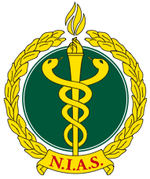Northern Ireland Ambulance Service
The Northern Ireland Ambulance Service (NIAS) is an ambulance service that serves the whole of Northern Ireland (approx 1.8 million people). As with other ambulance services in the United Kingdom, it does not charge its patients directly for its services, but instead receives funding through general taxation. It responds to medical emergencies in Northern Ireland with the 300-plus ambulance vehicles at its disposal. Its fleet includes mini-buses, ambulance officers' cars, support vehicles, RRVs and accident and emergency ambulances.
| Northern Ireland Ambulance Service | |
|---|---|
 | |
| Established | 1 April 1995 |
| Headquarters | Knockbracken Healthcare Park Saintfield Road Belfast BT8 8SG[1] |
| Region served | Northern Ireland |
| Area size | 5345 sq. miles |
| Population | 1.8 million |
| Establishments | 46 Stations and deployment points |
| Chair | Nicole Lappin |
| Chief executive | Michael Bloomfield |
| Staff | 1,300 (2018/19)[2] |
| Website | www |
History
The Northern Ireland Ambulance Service was formed on 1 April 1995 through the amalgamation of its 4 predecessors. Its full title is the Northern Ireland Ambulance Service Health and Social Care Trust.
Services
The Service employs approximately 1,300 staff of which approximately 420 are Paramedics, 300 are EMTs and 100 are Control staff, which work shift patterns to ensure the service is operational 24/7. They are based across 46 stations & sub-stations, 2 Control Centres (Emergency and Non-emergency) and a Regional Ambulance Training Centre. It responds to approximately 201,000 emergency (999) calls per year (with the number of 999 calls is increasing per year) with a combination of traditional emergency ambulances with two crew members, and rapid response vehicles (RRVs) crewed by a single paramedic. RRV's respond mostly to calls where there is a potential immediate life-threat (Category A) because they can respond more quickly than a conventional ambulance. Double-crew ambulances respond to both Emergency and Non-emergency (Healthcare Professional-initiated urgent) calls as well as providing critical-care transfers between hospitals. The Trust aims to provide at least one Paramedic to every emergency call by staffing each double-crew, emergency ambulance with two Paramedics or a Paramedic and an Emergency Medical Technician and utilising Rapid Response Vehicles. The Trust has not adopted the controversial use of ECA's in the way many other UK Ambulance Services have.
In 2019 the service entered a partnership with the Ulster University to deliver a Foundation Degree in Paramedic Science, with the first cohort of trainees graduating in December 2019. Further cohorts are scheduled until a BSc honours degree commences in line with future requirements for professional registration of UK paramedics.
In addition to the emergency service, NIAS has a fleet of Patient Care Service vehicles which are used for more routine patient transport to/from hospital. Within the Patient Care Service there are both single-crewed 'sitting case' (minibus) vehicles as well as double-crewed 'intermediate care vehicles' (ICV) which carry a stretcher.
In 2016 NIAS was commissioned to provide a Helicopter Emergency Medical Service (HEMS) for the first time in Northern Ireland which was by then the only region of the UK not to have one. Following a public consultation, they partnered with the charity Air Ambulance Northern Ireland who provide the aircraft and airbase, with the doctors and paramedics provided by NIAS. The service undertook its first live mission in August 2017.
Performance
NIAS currently has a target time of 8 minutes to reach the scene of an emergency although, during December 2017 only 47.5% of this target was met therefore the average response time in Northern Ireland was 16 minutes 10 seconds.[3] Currently the trust works with volunteer and private ambulance services to help cope and meet key response times, this is due to the current increased demand and squeeze on public spending across Northern Ireland [4] Staff have expressed concern by the growing pressures they face and overall low morale across the service.[5] The ambulance service aims to restructure the service to cope with future increased demand.
In September 2018, the ambulance service requested an additional £30 million in funding from the Department of Health to restructure the service and to recruit an additional 300 staff members, most of whom would be paramedics, EMTs and emergency call takers. The recruitment is meant to quicken response times and relieve pressure on staff.[6]
See also
- Emergency medical services in the United Kingdom
- National Health Service
- List of Government departments and agencies in Northern Ireland
- HSE National Ambulance Service – Ambulance service in the Republic of Ireland
References
- "Area Contact Details". Northern Ireland Ambulance Service. Retrieved 3 December 2019.
- "Annual Report and Accounts for Year Ended 31 March 2019" (PDF). Northern Ireland Ambulance Service. Retrieved 3 December 2019.
- "A Meeting of Trust Board" (PDF). Northern Ireland Ambulance Service. 1 February 2018. Retrieved 19 February 2018.
- "St John's Ambulance thanks Northern Ireland volunteers for work over busy winter". BelfastTelegraph.co.uk. ISSN 0307-1235. Retrieved 15 January 2018.
- "We've no confidence in bosses, Northern Ireland Ambulance Service staff say". BelfastTelegraph.co.uk. ISSN 0307-1235. Retrieved 31 January 2019.
- Rice, Clodagh (27 September 2018). "Demand jumps for NI ambulance services". BBC News. Retrieved 30 September 2018.
External links
| Wikimedia Commons has media related to Northern Ireland Ambulance Service. |